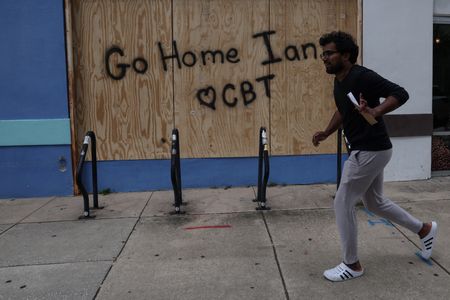By Brad Brooks
SARASOTA, Fla. (Reuters) -Residents of Florida’s Gulf Coast on Tuesday boarded up homes, packed up their vehicles and headed for higher ground as Hurricane Ian drew near, threatening to bring a deadly storm surge and more than a foot of rain to some areas.
Ian churned across the southeastern edge of the Gulf of Mexico headed for Florida after slamming into Cuba earlier in the day, leaving the entire country without power, forcing mass evacuations and swamping fishing villages.
More than 2.5 million Floridians were under evacuation orders or warnings with the sprawling storm on track to make landfall as a Category 3 or Category 4 hurricane on Wednesday evening somewhere along Florida’s Gulf Coast.
A Category 3 storm on the five-step Saffir-Simpson scale carries maximum sustained winds of up to 129 miles per hour (208 km per hour). The latest 8 p.m. EDT (2100 GMT) hurricane advisory put Ian’s top winds at 120 mph (195 km per hour).
Ian was most likely to come ashore south of Tampa near Sarasota, the National Hurricane Center (NHC) said. That region – home to miles of sandy beaches, scores of resort hotels and numerous mobile home parks – is a favorite with retirees and vacationers alike.
“I know I should be scared of this one, but I’m too busy to be scared. I just know we have to go,” said John O’Leary, a jazz pianist from Tampa, said as he and his wife loaded food, water and family photos into their car before heading to his mother’s house in Palm Harbor, 25 miles (40 km) to the west.
O’Leary, 36, was one of the thousands of motorists to hit the road as they fled low-lying areas in hopes of avoiding a potentially life-threatening storm surge that, according to forecasters, could reach 12 feet (3.7 meters) in the Sarasota area.
While predictions remained imprecise for where the storm would come ashore, “the impacts are going to be far, far broader than just where the eye of the storm happens to make landfall,” Governor Ron DeSantis said.
DeSantis warned of the potential for devastating Hurricane Harvey-like flooding that struck the Houston area in 2017, the result of a slow-moving storm piling up high water.
Parts of central Florida could see as much of 2 feet (0.6 meter) of rain from Ian, according to the National Weather Service. The NHC also issued extensive storm surge warnings for about half of western Florida’s shoreline, with predictions of life-threatening coastal flooding up to 12 feet from wind-driven high surf.
Florida’s director of emergency management, Kevin Guthrie, urged residents in evacuation zones to move to safety.
“The time to evacuate is now. Get on the road,” he said.
To ease traffic congestion, authorities suspended toll collections along major highways in central Florida, the Tampa Bay area and the interstate stretch across the Everglades known as Alligator Alley.
Some residents, such as Vanessa Vazquez, 50, a software engineer in St. Petersburg, said they planned to ride out the storm at home despite evacuation warnings.
“I’m staying put,” Vazquez said. “I have four cats and I don’t want to stress them out. And we have a strong house.”
If Ian strikes Tampa, it would be the first hurricane to make landfall in the area since the Tarpon Springs storm in 1921.
It also may prove one of the costliest as the latest simulations projected storm-related damages ranging from $38 billion to more than $60 billion, Enki Research said on Tuesday.
CLOSINGS, POWER OUTAGES
Nearly 60 Florida school districts were either closed Tuesday or planned to be closed by Wednesday, DeSantis said. Many of those schools were designated as shelters for the storm and its aftermath.
Commercial airlines canceled more than 2,000 U.S. flights due to the storm.
The St. Petersburg-Clearwater International Airport – located on a vulnerable peninsula east of Tampa Bay – ceased operations at midday, and the Tampa International Airport shut down a few hours later.
Tampa Electric warned customers to be prepared for “extended outages.” The company will institute a “targeted interruption” of service to a part of downtown Tampa on the western edge of the city. That area has already been evacuated.
DeSantis said nearly 100 evacuation shelters had opened statewide.
“This is a mobile home community, and they really need this shelter,” said Fabiola Galvan Leon, a preschool teacher acting as a bilingual translator for hundreds of evacuees flocking to Reddick Elementary in Wimauma, Florida, southeast of Tampa, to ride out the storm.
The shelves at a nearby Walmart store had been stripped almost bare, though a contingent of shoppers wandered the aisles, hurriedly grabbing the last remaining boxes of water, canned goods and loaves of bread.
The Walt Disney Co announced it was closing its Florida theme and water parks on Wednesday and Thursday while the National Football League’s Tampa Bay Buccaneers relocated to Miami, where they will practice this week ahead of their game against the Kansas City Chiefs on Sunday.
Read more:
FEMA warns Florida against complacency as Hurricane Ian nears
The worst hurricanes in Florida’s history as Ian takes aim
How climate change is fueling hurricanes
U.S. offshore oil output drops as Hurricane Ian takes aim
(Reporting by Shannon Stapleton in Tampa and Brendan O’Brien in Washington; Additional reporting by Maria Alejandra Cardona in Tampa, Tyler Clifford in Washington, Dan Whitcomb in Los Angeles and Rich McKay in Atlanta; Writing by Brendan O’Brien and Steve Gorman; Editing by Frank McGurty, Lisa Shumaker & Shri Navaratnam)





